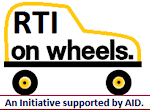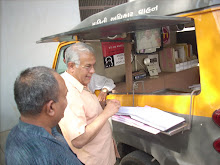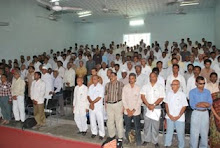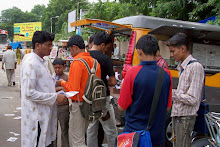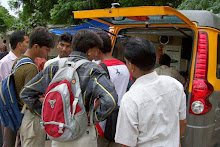Livemint:
Rajasthan: Monday, 19 October 2015.
What is
happening in Rajasthan for the past four months must be replicated across India.
After all, education is the most neglected area in India, and the situation in
government schools remains pathetic, with no sign of any improvement in the
future.
It is obvious
that what we invest today in education would only be converted into something
fruitful after a couple of decades. It means that if we are neglecting our
schools today, we are not only neglecting our children and depriving them of
education, but we are also ensuring that we fall behind at least two to three
decades.
Recently, girl
students of a higher secondary school in Chauru village in Tonk district of
Rajasthan were beaten up with batons by the police. They were just protesting
against the lack of teachers in their school. Interestingly, such protests are
taking place all over the state, especially in girls’ schools, partly motivated
by a statewide campaign called Shiksha Ka Sawaal (SKS). The campaign has been
conceived by Soochna Evam Rozgaar Adhikar Abhiyan and Rajasthan Patrika, a
Hindi newspaper. According to the Abhiyan, which has been formed by hundreds of
civil society organizations, “SKS is a year-long campaign from March 2015 to
February 2016 using RTI (right to information) as a means to initiate citizen
monitoring of government schools and public education across the state.”
The protest
started on 2 October 2014 when 700 students of a girls’ school in Bhim came out
on the road and demanded that they should have more than the paltry four
teachers in their school. Even today, this school does not have teachers in the
double digits, while the boys’ secondary school in the neighbourhood has more
than 25 teachers, which is being seen as a clear case of discrimination.
It must be
noted that last year, the Rajasthan government merged 17,129 schools with
13,536 senior secondary schools, claiming that those schools either had no
enrolled students or only a few. After the integration, the total number of
schools came down from 82,869 to 65,740. As a result, the state found that
there were about 10,000 surplus teachers who were supposed to be transferred
across various schools. Meanwhile, information sought under RTI reveals that
the situation of state-run schools is not only pathetic but also in violation
of each and every pillar of the federal right to education law.
For example,
according to the Abhiyan’s surveys, there are more than 40% vacancies of
teachers in secondary and senior secondary schools. Interestingly, the SKS
campaign started with the simple approach of mobilizing the students and
parents to file RTI applications in every school and ask five basic questions:
1) Teachers and students—number of posts, vacancies; number of children,
attendance, dropouts, etc; 2) Playgrounds—whether there is one, its status,
coordinates, whether it has been encroached upon, whether it has a boundary
wall, etc; 3) Toilets—the numbers for girls, boys and staff, their working
condition and water source; 4) Safe drinking water, including source and
hygiene; and 5) School Management Committees (SMCs)—their membership, their
resolutions if any, and copies of the School Development Plan (SDP).
To maximize
the outreach, the Abhiyan formed a group of about 1,200 volunteers and college
interns and spread them across 295 blocks of 33 districts in the state for
about one-two months and asked them to mobilize people at the village level and
identify local, village-level schools and file RTI applications.
So far, the
campaign has resulted in more than 1,000 articles and reports in the Rajasthan
Patrika, thousands of RTIs, and more than 400 Tala-Bandis (student-led
lockouts, where students lock the gates and sit in front of the schools). The
majority of the demands have been for filling teacher vacancies. In some
places, the sanctioned positions are over 20 and the staff present are three or
four. It is noteworthy that girl students have led many of the Tala-Bandis.
Incidentally,
The Digital Empowerment Foundation was also involved in the campaign by
facilitating tablet-based surveys of the schools based on the five questions
mentioned above. The outcome of the surveys and RTIs filed are revealing.
There is a
distinct lack of adequate numbers of teachers; thousands of schools have fewer
than two teachers; there is no clear and transparent transfer policy for the
teachers; there is a dearth of community participation and most of the SMCs
exist only on paper. In most cases, the parents are unaware of school
committees; 56% of the schools have not held SMCs; more than 80% of the schools
do not have functional toilets; encroachment of school land and playground is a
major issue; 68% of the schools do not have a playground at all; and out of the
selected 10,000 government schools to be converted into a model school, only 80
are girls’ schools.
The good news
is that the people’s movement has yielded some positive results. For example,
each school principal is also a public information officer who can receive RTI
applications. The government has declared that each school will have a monthly
Abhibhawak Divas (parents’ day) when parents and teachers meet to discuss
school issues. Every two months, there will be Shiksha Samvad a dialogue
between the media, school, teachers, parents and the education minister, along
with education secretaries. The state government will set up a helpline to
record all education-related grievances and a special grievance redressal cell
to deal with education-related complaints. It has also promised to build
boundary walls for all schools by using the rural jobs guarantee scheme.
The community
should exercise its rights with regard to government schools. There should be
constant follow-ups and the community must demand disclosures from the
government. All the monitoring and evaluation need to be enabled with a robust
online platform, which should have active and equal participation from the
government, teachers, parents, children, media and civil society.




